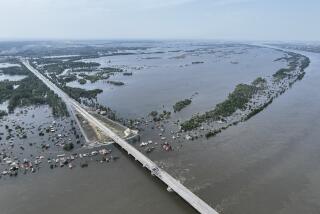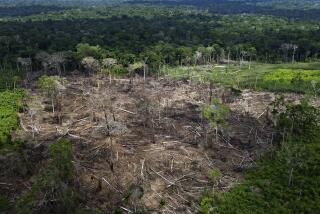6,000 Toil in Czechoslovakia Forests to Undo Effects of ‘an Ecological Catastrophe’
- Share via
LITVINOV, Czechoslovakia — Miroslav Pulicar grew up in the forests of northern Bohemia and watched them die over the years in what he calls “an ecological catastrophe.”
Now he is trying to bring them back to life.
Pulicar is one of 6,000 people who toil daily in the Most region near the East German border. They plant trees, fill in old mine shafts, purify water and do everything else they can to bring the color green back to the hilly landscapes scarred by industrial pollution.
A director of one of two forestry concerns in Litvinov, Pulicar said that industrialization in the area goes back to the 19th Century and was accelerated by Nazi occupiers in World War II.
Damage Accelerated
“Man has been in conflict with nature here for 200 years,” he said.
But he said that environmental damage accelerated dramatically during the 1960s and 1970s, when heating plants fueled by northern Bohemia’s brown coal sprouted and suffocated the trees with sulfur and other emissions.
“A few months after each came on line, you saw the effect,” he said.
By 1973, local foresters had to cut down twice as many dead trees in one year than during all of the late 1960s, he said.
Water Pollution
The denuding of the forests also brought on soil erosion and threatened the purity of water--doubly important in a country with no major rivers.
Vladimir Soukup, head of the department of ecology in Most, said that Czechoslovakia was slow to react to the disaster.
“There were many other serious economic problems and ecology was not considered that important,” he said.
But now both he and Pulicar, lifelong inhabitants of the region, say they are optimistic about reviving some of the lost forest.
Signs of Life
“We’re finding mushrooms and berries in the woods again,” Soukup said.
Pulicar proudly points to what he calls his “presents from North America”--hardy, young silver spruce trees whose needles have a thick layer of wax that blocks pollution damage.
Foresters in the region were faced with what Pulicar called the worst tree damage in central and Western Europe and had to experiment with different trees and growing methods before finding the right mix.
In addition, Pulicar said, pollution is decreasing now that Czechoslovakia has imported filters to cut the emission of sulfur and other chemicals from industrial plants.
Costly Filters
“That’s the source of our optimism,” he said. “Otherwise, our work would be meaningless.”
But just one filter installed in the Tusimice power station west of Most costs $200 million.
Soukup reckoned that it costs $15,000 to recultivate 2.47 acres of forest.
Pollution also is a problem in other parts of Czechoslovakia. The air is poor in Prague, the nation’s capital. In Bratislava, 60 doctors, scientists and historians have issued an unofficial report that says the instance of cancerous tumors rose more than 35% between 1980 and 1985 and that infant mortality is 65% higher than in 1960.
Change of Life
Pollution changed the way of life in northern Bohemia.
For years, the population of the region declined as people fled, fearing for their health.
Partly as a result, several hundred Vietnamese workers were imported to help with the planting of new trees on wind-swept hills.
Anti-pollution plans now call for most of the dirtiest plants and industries to be shut down by the year 2000 and replaced by lighter, consumer-oriented industries.
Soukup said that since 1984, migration has eased, perhaps because of benefits the Communist government in Prague now awards local citizens.
More to Read
Sign up for Essential California
The most important California stories and recommendations in your inbox every morning.
You may occasionally receive promotional content from the Los Angeles Times.













